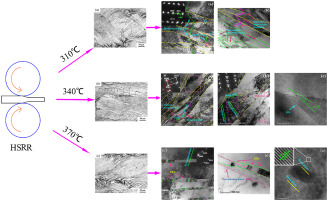Materials Science and Engineering: A ( IF 6.1 ) Pub Date : 2020-03-10 , DOI: 10.1016/j.msea.2020.139221 Yan Xu , Xuxing Zhang , Wei Li , Penghong Hu , Jianbo Jia , Junting Luo

|
The rolled sheet was successfully prepared for the as-cast AM60B magnesium alloy by using the high strain rate rolling (HSRR) in the temperature range of 310 °C – 370 °C. An ultrafine lamellar structure consisting of small angle grain boundaries was developed in the HSRRed sheet by the detwinning of high-density twins. The ultrafine lamellar structure was characterized by means of the high-resolution transmission electron microscopy technique, and the effect of temperature on the detwinning was analyzed. Furthermore, the morphological difference of the ultrafine lamellar structure and its effect on the mechanical properties of the rolled sheet were investigated. The results show that the dislocation motion, cross twinning, dynamic recovery and dynamic recrystallization have multiple interactions with the detwinning behavior in different modes. And the degree of detwinning and the post-rolling microstructure are greatly affected by the interaction. Dynamic precipitation of the second phase is induced by the HSRR process at 370 °C. Nano particles precipitate along twin grain boundaries and form the ‘precipitation band’. However, the detwinning is not affected by the ‘precipitation band’. In addition, it is also revealed from the results that a uniform and fine fully-lamellar structure is developed as the HSRR process is conducted at a medium temperature of 340 °C. Meanwhile, the alloy rolled at 340 °C has relatively optimal mechanical properties, and the strength and ductility are well balanced.
中文翻译:

高应变速率轧制超细层状结构AM60B镁合金薄板
通过在310°C – 370°C的温度范围内使用高应变率轧制(HSRR),成功地为AM60B铸镁合金制备了轧制板。通过高密度孪晶的解缠,在HSRRed薄板中形成了由小角度晶界组成的超细层状结构。利用高分辨率透射电镜技术表征了超细层状结构,并分析了温度对脱膜的影响。此外,研究了超细层状结构的形态差异及其对压延板机械性能的影响。结果表明,位错运动,交叉孪生,动态恢复和动态重结晶与脱模行为在不同模式下具有多种相互作用。脱脂度和轧制后的微观结构受相互作用的影响很大。HSRR过程在370°C诱导第二相的动态沉淀。纳米颗粒沿着双晶界沉淀并形成“沉淀带”。但是,解缠不受“降水带”的影响。此外,从结果还可以看出,在340°C的中等温度下进行HSRR工艺时,形成了均匀且精细的全层状结构。同时,在340℃下轧制的合金具有相对最佳的机械性能,并且强度和延展性很好地平衡。纳米颗粒沿着双晶界沉淀并形成“沉淀带”。但是,解缠不受“降水带”的影响。另外,从结果还揭示出,当HSRR工艺在340℃的中等温度下进行时,形成了均匀且精细的全层状结构。同时,在340℃下轧制的合金具有相对最佳的机械性能,并且强度和延展性很好地平衡。纳米颗粒沿着双晶界沉淀并形成“沉淀带”。但是,解缠不受“降水带”的影响。另外,从结果还表明,当在340℃的中等温度下进行HSRR过程时,形成了均匀且精细的全层状结构。同时,在340℃下轧制的合金具有相对最佳的机械性能,并且强度和延展性很好地平衡。











































 京公网安备 11010802027423号
京公网安备 11010802027423号